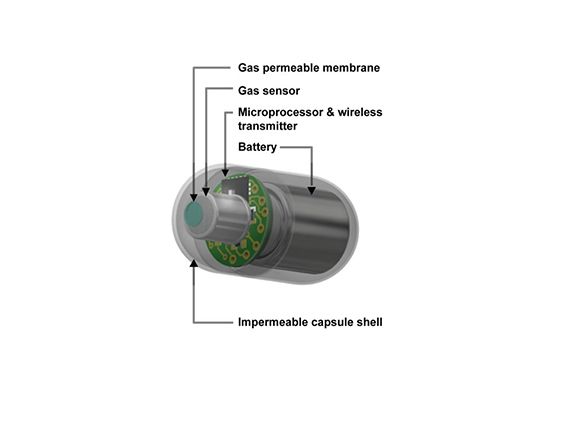Fecal Fermentation and Electronic Pills May Help Decipher Gut Gases
Some intestinal gases have been linked with diseases such as irritable bowel syndrome and colon cancer, so tracking them might explain the connection
/https://tf-cmsv2-smithsonianmag-media.s3.amazonaws.com/filer/44/4a/444a9faf-ac80-4a6c-b56e-82370cdcc165/intestines3.jpg)
The trend of today might be wearable tech, but a research team in Melbourne, Australia seeks to make major strides with the ingestible variety. This week Kourosh Kalantar-zadeh and his colleagues at RMIT University released a paper in Trends in Biotechnology outlining the potential of ingestible electronic capsules to provide accurate measurements of intestinal gases. Such technologies, they argue, would offer deeper, real-time insight into the gases’ activities inside the body and their suspected relationships with certain diseases.
Our digestive system is more than just internal organs at work. We also need our gut microbiome, an entire ecosystem of diverse bacteria that helps break down the food we eat via fermentation. Although some of the intestinal gases we emit are due to swallowed air, others are created when different bacteria making up the microbiome metabolize substances in the gut.
Some studies suggest that certain gases can be useful markers of a person’s health status. For example, sulfate-reducing bacteria produce hydrogen sulfide, which has been linked with irritable bowel syndrome. Connections have also been made between the presence of some gut gases and inflammatory bowel disease and colon cancer. If these gases can be accurately detected and monitored, the information could help bolster research on the causes of these illnesses.
"The human gut's effect on gastrointestinal diseases consumes a significant portion of health care expenditure every year worldwide,” notes Kalantar-zadeh, emphasizing his new approach as a cost-effective way to help decipher the gut’s impact on overall health. Stanford professor and microbiologist David Relman agrees: “In general, the ability to monitor microbial community-wide functions, or ecosystem services, within the gut is a critical need and could add substantially to our understanding of their operations.”
Today, gases produced by the gut microbiome can be measured using an external device much like a Breathalyzer. However, a significant portion of the data is lost in the process, because gases get absorbed or diffused before the subject even has a chance to exhale. Another technique involves analyzing fecal matter, which faces similar challenges given the time lag involved, along with the difficulty of connecting data points about a gas’ presence with exact places in the digestive tract, explains Lawrence David, an assistant professor studying microbiomes at Duke.
Kalantar-zadeh set out to look for a direct method that could potentially produce more precise, comprehensive readings.
His analysis landed on two strategies: fecal fermentation systems and ingestible gas capsules. In the first method, fecal matter is incubated in conditions that simulate those of the large intestine. The feces contain bacteria from the gut, so fermenting it mimics the types of reactions taking place within the body. The second is by far the most direct sampling method—bringing the lab work straight into the gut by way of an electronic pill.
“The two practices are noninvasive and, in comparison to relevant methods, are much more accurate, as they take the gas samples where they are produced,” says Kalantar-zadeh.

The gas-monitoring capsules, forecast by Kalantar-zadeh to cost less than $10 a piece, look like tablets that patients can swallow. Included in each capsule are two key components: a sensor that monitors the presence of different intestinal gases and a battery to serve as a power supply. Recent developments in technology have led to gas sensors that are less than 10 millimeters long. The sensor is hooked up to a microprocessor and a wireless transmitter that conveys the data to an external recorder.
The electronics are encased in an impermeable capsule shell able to withstand the high humidity of the intestine, but with a gas-permeable membrane near the sensor. The sensors drain large amounts of energy because they operate at high temperatures, so Kalantar-zadeh thinks lithium-ion batteries are the optimal energy source due to their high voltage and charge capacities.
The capsules build on micro-technology that’s been established by ingestible pH, pressure and temperature sensors like the SmartPill and endoscopic cameras that patients can swallow to capture images of the digestive tract. The length of time each gas capsule would remains inside the body is dependent on how quickly a person’s digestive tract operates, ranging anywhere from one to several days, says Kalantar-zadeh. Along with collaborators at the University of Melbourne, Monash University and CSIRO, his team is currently testing pill prototypes on pigs. They aim to publish these results soon and then hope to obtain approval for clinical trials with humans.
Gelman and David are both excited by the prospect of this technology, along with the wealth of data it could ultimately collect. Gathering a critical mass of information is a key next step to gaining a solid understanding of the impact intestinal gases have on health conditions and treatments, they note.
“Clinical utility will require a lot more data and insight as to which components correlate with and predict ecosystem health and disease,” says Relman.
/https://tf-cmsv2-smithsonianmag-media.s3.amazonaws.com/accounts/headshot/profile.jpg)
/https://tf-cmsv2-smithsonianmag-media.s3.amazonaws.com/accounts/headshot/profile.jpg)